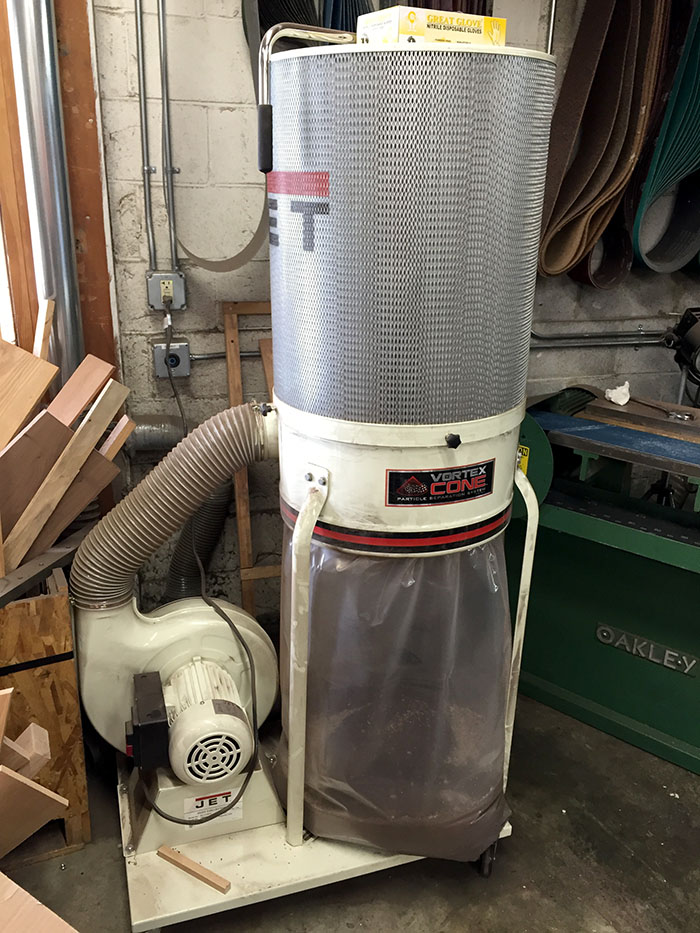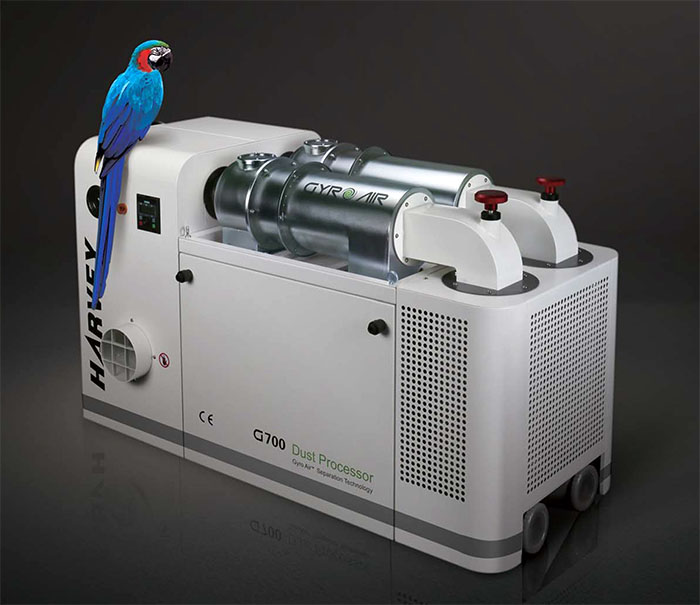Drivel Starved Nation!
Last fall when I was in China, I was able to witness the introduction of a new type of dust collector (Pat. Pending) to the international market. The makers, Harvey Works, the same folks that make our innovative Chopstick Master™ unveiled a new dust collector concept that was 5 years in the making — it is called the Gyro Air™.
I ordered one immediately and here is why;
This is the dust collector in the Bridge City skunk lab:
 Your dust collector is likely almost identical — this is the most commonly found cyclone dust collector in small shops the world around.
Your dust collector is likely almost identical — this is the most commonly found cyclone dust collector in small shops the world around.
The problem with this paddle wheel collector is three-fold, it is not easy to empty when the bag is full (particularly if you are old like me), it is just TOO DAMN LOUD, and lastly, there is still too much fine dust released back into the shop. Ours also has a leak where the bag attaches to rim. This dust collector is so loud the tenant above our shop has had “talks” with me about this noise. “Not much I can do”, I yelled.
Harvey is breaking with tradition with a new patented technology (nine separate patents) that completely changes how you view, hear, and breathe dust collection. The secret is pictured below;
The patented twin impellers do a better job of creating suction while at the same time, dramatically reducing noise. How much less noise you say? You can talk on the phone while the Gyro Air is running right next to you for starters. So to paraphrase former presidential candidate Ross Perot, “There is no giant sucking sound here!”
While at the Harvey factory, I also observed something interesting about dust collector CFM ratings. They are not truthful in most cases. And the reason? A true measure of a dust collector’s suction capability has to be measured when hooked up to the ducting, in other words, under load. The end result is this: if you owned a Gyro Air you can say to your woodworking friends that your dust collector sucks more than theirs. How cool is that?
The GYRO Air actually separates extracted dust and chips into separate bags which I found fascinating—chips in one bag, flour dust in the other. (I might have to buy some hamsters now…) And because they are enclosed within the unit, there is an indicator light that lets you know when they are full. Although the capacity is slightly smaller than our existing collector, I don’t have to worry about blowing out my back emptying the bags. For my old back, that is a huge benefit. The separation makes it much easier to use the chips and dust as mulch. The clean air circulated back into your shop passes through a 5 micron filter and a one micron HEPA filter is available as an option. While in China there was significant interest in the Gyro Air for hospital use which I found interesting as well.
The Gyro Air is on wheels, so you can position it where you want. It also has a stepped inlet so you can use it as a non-wet shop vac. But for me, the noise reduction is worth it’s weight in decibels… Did I just write that?
This thing is just plain cool.
My unit will be here in a couple of weeks and I will post pics once it is hooked up, which is easy because all I have to do is plug it in and turn it on. The retail price in the USA is $3995 (Shipping is free to the lower 48 states). Inventory, parts and warranty service will be handled out of the Harvey Los Angeles office. Warranty is five years mechanical and three years on the electrical side. Interestingly, in order to sell these units in Europe, where quality standards are higher than they are here (which is embarrassing in my opinion), only top notch electrical components from Siemens are used, including the motor. The entire unit is built modular, so if a repair is ever required, the user swaps out whatever needs swapping.
As most of you are aware, I am genetically attracted to the best man has to offer, and I believe the Gyro Air is a complete game changer. I am pleased that Bridge City can play a small role in the American market. If you would like to be one of the first to add this amazing machine to your shop, give us a jingle; 800-253-3332, $500 down and you can join me as the first to employ a Gyro Air in America. The first wave of units headed for the Los Angeles warehouse will arrive in mid-September. Again, shipping is free in the lower 48 states.
Don’t ask me about the blue parrot. I have no clue other than it says “Gyro Air Sucks”.
The drawback to the Gyro Air while it is running? If others work in your shop and you are suffering from the previous nights double bean burrito, you will need to step outside your shop to keep from embarrassing yourself—and I know you hate that.
-John
PS: If you have tech questions, here is all I know and if you need a higher resolution version, click here to download the PDF file;




https://www.youtube.com/watch?v=Kf8z9olsRQo
I really like that it’s parrot safe- been holding off on getting a parrot because of my old dust collector!
Seriously, looks to be a very nice unit John, do you know if it could hooked up to a trunk/gates/multiple machine system?
Yes, as long as you have blast gates on your lines, it will work just like any other dust collector, with a lot less noise.
Really Interesting.
I will be really curious to hear (no pun intended) about your impressions in use. I will be re-assembling my shop again in the coming months and have been thinking very seriously about how to deal with dust collection and air filtration.
I can’t wait to share my report and the DSN will be the first to know.
-John
According to the spec you’ve posted, it’s 1100 m^3 per hour.
That’s 38,846 ft^3 per hour or 647 cfm. (thanks google!)
That sounds low for an industrial application. Oneida’s run at 1000 CFM and up.
Now we all know posted numbers on a web site may not reflect reality.
I will be curious to read your report of real world test results. And how often you have to empty it.
I have spent around 20 hours watching this thing work, and would not have decided to use one personally if I wasn’t going to to be happy. It has plenty of suction for a small shop. The numbers of the various collectors out there often don’t reflect reality. The numbers on the Gyro Air are spot on, because they have to be to sell in Europe in the various sectors they are targeting. I don’t think people will tolerate bogus numbers on a machine of this expense. A $399 import special? Don’t believe the numbers.
Regarding collection capacity, when I empty ours the bag is usually about half full because it so damn awkward to empty. I actually may get more capacity than what I am used to with the Gyro Air now that I think about it. That said, I don’t think we are a good example of judging how often it needs to be emptied because of the interment woodworking in our shop. That, and most of what we do over there is metal work.
Speaking of dust collecting, the vacuum system on the Festool random orbit sander is unbelievable – the best I have ever used.
-John
I hear you. I own one of those 399 specials and I’m sure I don’t get anywhere close to the CFM that was advertised.
The thought of a quieter system has lots of appeal, especially with SWMBO who grumbles when I’ve got it running.
Nice unit. It’s larger than it looks. Must be the big birds in China.
Dimensions are 57w x 24d x 34h. Weight is 430 pounds!
I replaced my Powermatic single stage unit about two years ago with a Laguna two-stage. It was $900 on sale at Rockler. It’s a LOT quieter and much better suction. 74db and 1100 CFM rated. I have a CFM test unit and I get about 1000 at the collector, and 500 CFM at the most distant tool in my shop, which is about 35 feet of pipe away.
Getting that unit down basement steps might be a challenge.
Anxious to get your feedback on it. Thanks for sharing.
How much did it cost?
$3900
Hello!
Any update on the dust collector? Is it shipping already?
Thanks!
Alex
The first batch are on the boat, should be in LA at the end of Nov. My review will be done in about a week (I have been out of the office for most of OCT.)
-John
Interesting design.
It looks different from other dust collection systems.